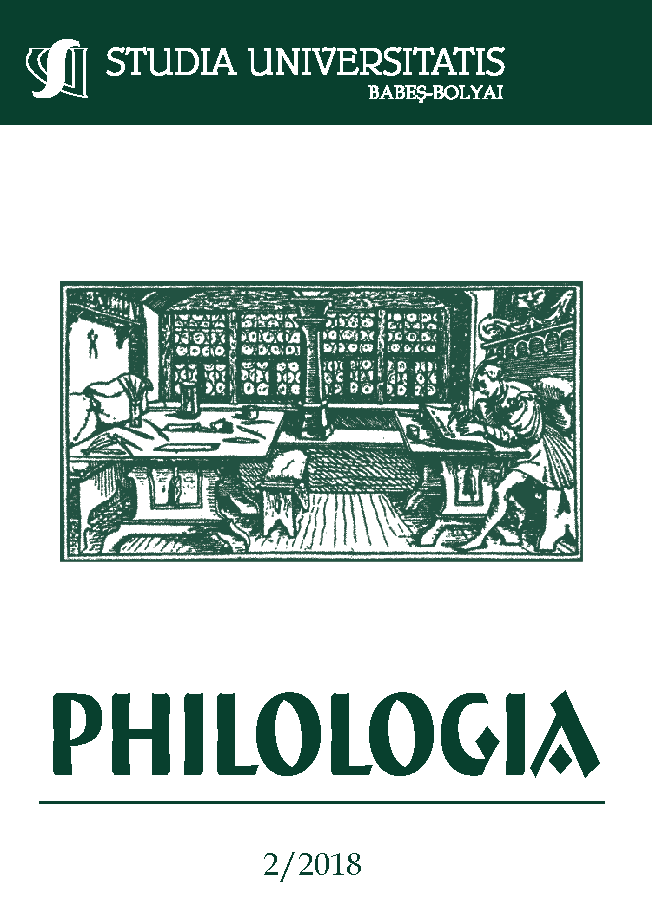POUR UNE APPROCHE SÉMIOLOGIQUE DE L’ORAL: ILLUSTRATIONS À PARTIR DES « FIGURES D’ACTION »
DOI:
https://doi.org/10.24193/subbphilo.2018.2.01Keywords:
Oral, Language, Semiotic units, Discourse types, Action figures, Development, Professional activity.Abstract
For a semiological approach of the oral: illustrations from “action figures”. This article aims to show the theoretical and empirical interest of a semiological approach to oral phenomena. The thesis underlying this approach is that of the continuity between oral and written phenomena, conceived as manifestations of human language that share the property of semioticity. The first part of the article presents the context of our reflection and its anchoring in the psychological and educational problem of human development. Based on Ferdinand de Saussure’s real work, the second part analyzes the way semiotic units and linguistic signs have been conceptualized in his theory, discussing the implications of this conceptualization for human significant process. The third part presents the results of empirical analysis of interviews with nurses concerning their professional activity. It brings out the different action figures put forward by the nurses, as well as the dependence of these figures on the discourse types and others linguistic choices. The last part discusses the status of action figures: a first approach focuses on their role in development, based on the production of meaning about professional activity; and a second approach demonstrates that action figures may be considered as macro-signs, or semiotic units, that allow different forms of reasoning.
REZUMAT. Pentru o abordare semiologică a discursului oral: ilustrări ale „figurilor de acțiune”. Acest articol își propune să arate interesul teoretic și empiric pentru abordarea semiologică a fenomenului oral. Teza pe care se bazează această abordare este continuitatea între scris și oral, ambele fenomene fiind concepute drept manifestări ale limbajului uman ce au proprietatea semioticității. Prima parte a articolului prezintă contextul reflecției noastre și plasarea acesteia în problematica psihologică și educațională a dezvoltării umane. Pornind de la lucrările lui Ferdinand de Saussure, a doua parte analizează modul în care unitățile semiotice și semnele lingvistice au fost conceptualizate în teoria acestuia, luând în discuție implicațiile acestei conceptualizări pentru procesul significant. A treia parte prezintă rezultatele analizei empirice a unor interviuri cu asistente medicale care au vorbit despre activitatea lor profesională. Sunt evidențiate diferite „figuri de acțiune” întrebuințate de către asistente, precum și relația de dependență dintre aceste figuri și tipurile de discurs sau alte alegeri lingvistice. Ultima parte a lucrării prezintă statutul „figurilor de acțiune”. O primă abordare se concentrează asupra rolului lor în dezvoltare, pe baza producerii de sens cu privire la activitatea profesională. A doua abordare demonstrează că „figurile de acțiune” pot fi considerate macro-semne sau unități semiotice, care permit diferite forme de gândire.
Cuvinte cheie: discurs oral, limbă, unități semiotice, tipuri de discurs, figuri de acțiune, dezvoltare, activitate profesională.
References
BLANCHE-BENVENISTE, C., Approches de la langue parlée en français. Paris: Ophrys, 2000.
BRONCKART, J.-P., Activité langagière, textes et discours. Pour un interactionisme socio-discursif. Paris: Delachaux et Niestlé, 1997.
BRONCKART, J.-P., Genres de textes, types de discours et “degrés” de langue. Hommage à François Rastier. Texto! [En ligne], Dialogues et débats, 2008, URL: http://www.revue-texto.net/index.php?id=86. (dernière consultation 17/03/2016).
BRONCKART, J.-P., BULEA, E. & BOTA, C. (Dir.), Le projet de Ferdinand de Saussure. Genève: Droz, 2010.
BULEA BRONCKART, E., « Types de discours et interprétation de l’agir: le potentiel développemental des figures d’action », in Estudos Linguísticos/Linguistics Studies, 3, Ediçoes Colibri/CLUNL Lisboa, 2009, pp. 135-152.
BULEA BRONCKART, E., Langage, interprétation de l’agir et développement. Sarrebruck: Presses Académiques Francophones, 2014.
BULEA BRONCKART, E. & BRONCKART, J.-P., « Les représentations de l’agir enseignant dans le cadre du genre ”entretien” », in Raído – UFGD, v. 6, n. 11, 2012, pp. 131-149.
BULEA BRONCKART, E. & JUSSEAUME, S., « Figures d’action et interprétation des dimensions didactiques de l’agir enseignant », in LIDIL, 49, 2014, pp. 51-70.
BULEA BRONCKART, E., FRAGA LEURQUIN, E. & DELANO VIDAL, F., « O agir do professor e as figuras de ação: por uma análise interacionista », in L. Bueno, M.-A. Paulino Teixeira Lopes & V. L. Lopes Cristovão (Dir.), Gêneros textuais e formação inicial: uma homenagem à Malu Matencio. Campinas-Sao Paulo: Mercado de letras, 2013, pp. 109-132.
CLOT, Y., « Clinique du travail et action sur soi », in J.-M. Baudouin & J. Friedrich (Ed.), Théories de l’action et éducation, Bruxelles: De Boeck, 2001, pp. 255-276.
CLOT, Y. & FAÏTA, D., « Genres et styles en analyse du travail. Concepts et méthodes », in Travailler, 4, 2000, pp. 7-42.
CONSTANTIN, E., « Linguistique générale. Cours de M. le professeur F. de Saussure », in Cahiers Ferdinand de Saussure, 58, 2005, pp. 71-289.
GRIZE, J.-B., Logique naturelle et communication. Paris: PUF, 1996.
KERBRAT-ORECCHIONI, C., Les interactions verbales. Paris: Armand Colin [tome 1], 1990.
POP, L., La grammaire graduelle, à une virgule près. Berne: Peter Lang, 2005.
RABATEL, A. (Ed.), Interactions orales en contexte didactique. Lyon: Presses Universitaires de Lyon, 2004.
SAUSSURE, F. (de), Cours de linguistique générale. Paris: Payot [Introduction et notes de T. De Mauro], 1916/1995.
SAUSSURE, F. (de), Ecrits de linguistique générale. Paris: Gallimard, 2002.
VANHULLE, S., Des savoirs en jeu aux savoirs en « je ». Berne: Peter Lang, 2009.
VERMERSCH, P., L’entretien d’explicitation en formation initiale et en formation continue. Paris: ESF, 1994.
VYGOTSKI, L.S., Pensée et langage. Paris: La Dispute, 1934/1997.
Downloads
Published
How to Cite
Issue
Section
License
Copyright (c) 2018 Studia Universitatis Babeș-Bolyai Philologia

This work is licensed under a Creative Commons Attribution-NonCommercial-NoDerivatives 4.0 International License.





 ©Studia Universitatis Babeş-Bolyai Philologia. Published by Babeș-Bolyai University.
©Studia Universitatis Babeş-Bolyai Philologia. Published by Babeș-Bolyai University.